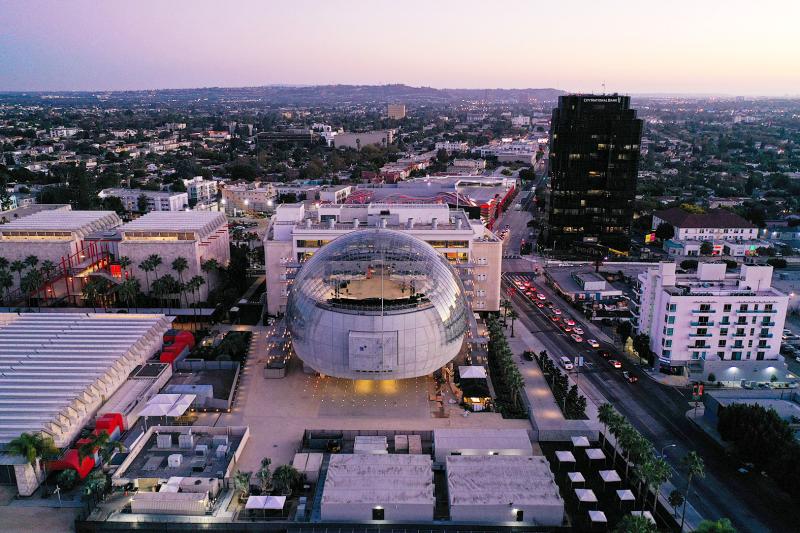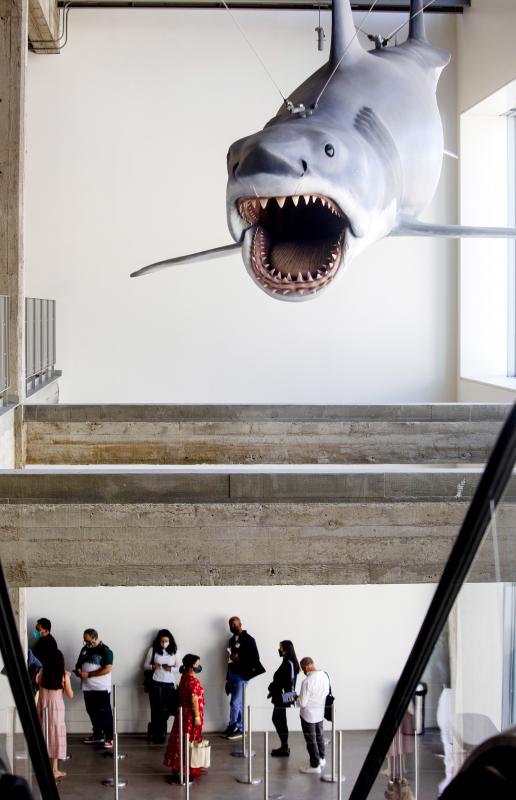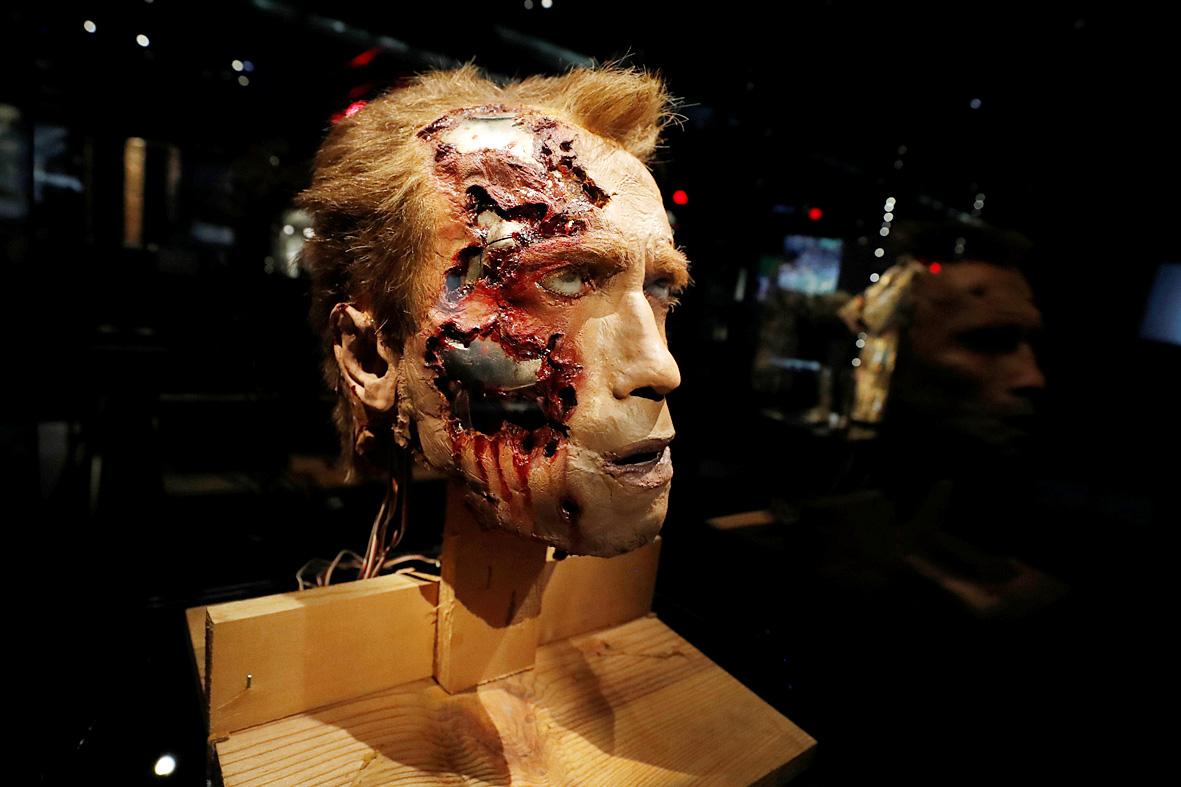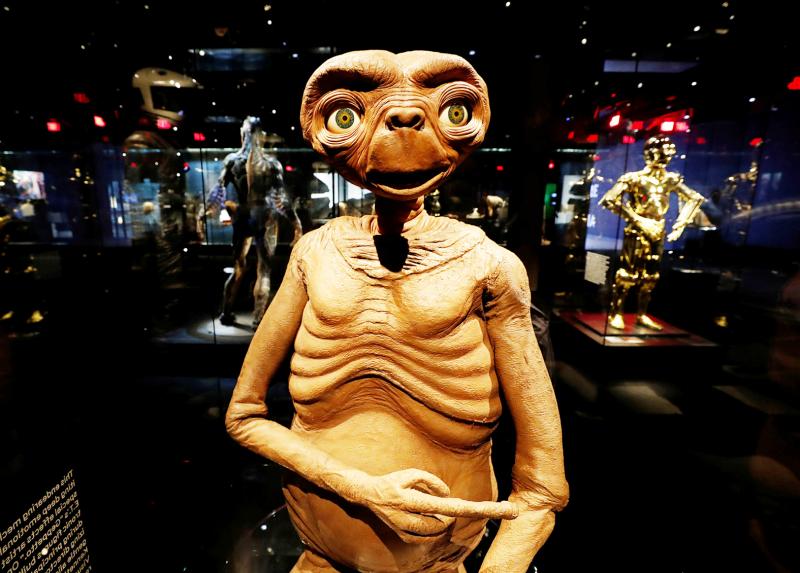In 1939, the Academy of Motion Pictures published its first “players directory,” which grouped actors into categories such as “leading women” and “comediennes,” but set aside separate sections for “colored” and “oriental” performers. The Academy removed the segregated categories a few years later, but many of the actors of color weren’t integrated into other sections. They were eliminated.
These racist directories are on display at the new Academy Museum of Motion Pictures in Los Angeles, which celebrates some of the most important film-makers in history while also attempting to confront head-on the dark legacy of exclusion and discrimination in the industry. The hope is to tell a much more complicated, and accurate, story of Hollywood through the years.
“As the Academy, we want to recognize our own complicity,” said Dara Jaffe, an assistant curator, on a recent tour before the official opening on Wednesday next week.

Photo: AFP
She pointed to a display on Anna May Wong, the lone Chinese-American movie star in the 1920s, who was denied leading roles. Nearby, the gallery features original casting notes on Al Pacino and youthful Polaroids of Christian Bale and Joaquin Phoenix from early auditions.
The messy and costly journey leading to the opening of the Academy Museum has run parallel to the rapid changes in Hollywood sparked by #OscarsSoWhite, #MeToo, Black Lives Matter and other movements pushing for inclusion in entertainment.
The result, after many delayed launches and leadership shakeups and much pandemic upheaval is a museum that is refreshingly critical of Hollywood’s failings — even if there are limits to the extent an institution affiliated with the Academy can address the reality of ongoing exclusion and the role the Oscars play in perpetuating problems.

Photo: Bloomberg
“We’re celebrating moviemaking, but we’re also having hard conversations about components of our history that are less proud,” says Bill Kramer, the museum’s director. “We need to speak honestly about who we are as an industry.”
LONG TIME COMING
Designed by Renzo Piano in a restored 1930s streamline modern structure, the 28,000sq meter museum is a high-stakes endeavor for the Academy and for Hollywood. Since the 1920s, when the Academy was founded, a film museum has been a dream of the industry, says Kramer. But none of the past efforts have succeeded.

Photo: Reuters
In the 1960s, a group of industry leaders tried to build one across from the Hollywood Bowl — with LA sheriffs forcibly removing a homeowner who stood in the way and refused to give up his property. But financial problems and infighting derailed the project, and the land was eventually turned into a car park. Artifacts the group had acquired, including Fred Astaire’s tap shoes and Marlene Dietrich’s costumes, ended up in storage in a closed down jail.
In 2012, the Academy announced plans for a film museum in the movie capital of the world at the landmark May Company building, which was built as a department store in 1939 (a notable year in film history with the release of The Wizard of Oz). It was a gargantuan undertaking, involving a building with deteriorating features, and the Academy raised an initial US$100 million with Piano on board. In the end, that wasn’t enough, and financial setbacks have plagued the project, which took on more than US$300 million in debt in 2015, when construction began. The Academy promised an opening date in 2017 — and every year that followed, with Tom Hanks announcing during last year’s Oscars that it would finally open later that year. A month later, the pandemic hit.
Piano, known for designing Paris’s Pompidou Centre and London’s Shard, has said he would have been a film-maker if not an architect. He designed the museum so visitors cross a bridge from the renovated historic structure, which houses the museum collection, into a striking new glass-and-concrete sphere nicknamed the Death Star dome, featuring the new 1,000-seat Geffen Theater.

Photo: Reuters
‘HOW THE MAGIC IS CREATED’
The upside to the many delays was that the museum had time to rethink the concept, at the same time that marginalized artists were exposing industry discrimination and forcing the Academy to diversify. When the museum was preparing to launch in 2019, it promised to celebrate the “most important” aspect of cinema: “how the magic is created.” Nearly three years later, its approach and marketing feel more relevant.
“We’re living in a moment where more people and louder voices are calling on institutions to recognize harm that has been done in the past,” says Jacqueline Stewart, the museum’s chief artistic and programming officer, a film scholar and archivist who was hired in January. “We have to trace our cultural histories with open eyes. One of the risks we take when we don’t pay attention to our past is that we accept these exclusionary practices as the norm.”
The professor from Chicago, who in 2019 became Turner Classic Movies’ first black host, said the museum’s galleries reject the idea of a “canon of films” and instead presents “film histories, in the multiple, so we don’t march through periods in a linear way.”
The core exhibition, Stories of Cinema, spans three floors and challenges notions of who counts as an auteur and what works should be placed on a pedestal. A gallery called Significant Movies and Moviemakers features six works and artists, starting with a Citizen Kane display which includes the Rosebud sledge. Adjacent is a moving homage to Real Women Have Curves, a 2002 film about a Mexican American family in East LA by director Patricia Cardoso, who was critically acclaimed but has long been denied recognition and resources. The Oscars were criticized in 2013 after excluding one of the film’s stars, Lupe Ontiveros, from its In Memoriam montage.
“We made something that is worthy of a museum, and that is such a huge compliment,” says Effie Brown, who was a producer on Cardoso’s film and now chairs the Academy’s inclusion advisory committee, which includes Ruth Carter, the Black Panther costume designer; Arthur Dong, a scholar on Chinese representation in Hollywood; and Bird Runningwater, who directs an indigenous program at Sundance. The group helped curators ensure exhibits were contextual and not whitewashed.
“We’re in Los Angeles, which is very diverse, and I want people to see themselves reflected, to see their ancestors’ contributions, to see they’re not forgotten,” Brown says, adding: “I also want them to freak out and see the things that moved them when they were watching it on the big screen.”
Darnell Hunt, UCLA dean of social sciences, who publishes annual reports on Hollywood diversity, notes that the Academy until recently tended to deflect blame over exclusion, saying, “‘We don’t make the films, we’re just honoring what gets made.’” He says he hopes the museum won’t “ghettoize ‘diversity and inclusion’ into one little corner of the museum, but instead treat the issue as something that frames the entire history of Hollywood and what Hollywood is now.”
The museum appears to do an effective job of not tokenizing discussions of exclusion, although there is a small gallery called Impact/Reflection that rather crams in discussions of films related to Black Lives Matter, #MeToo, labour relations and climate change.
ACADEMY ‘FIRSTS’
An Oscars room features large screens with a rotation of notable speeches for Academy “firsts” throughout history, illustrating the shamefully slow pace of progress, with Rita Moreno (the first Latina actor to win in 1962) alongside Chloe Zhao (the first woman of color to win for directing, this year).
The gallery also includes 20 notable Oscar statuettes but leaves an empty display for Hattie McDaniel, whose 1939 Oscar for Gone With the Wind is missing and who was forced to sit at a segregated table during the ceremony.
A makeup and hairstyling exhibit includes prosthetics worn by Charlize Theron and Danny DeVito, along with a display of old makeups from the 1930s and 40s that were used for blackface and yellowface. An animation exhibit has a fascinating look at the long and pervasive history of racist imagery and sexual violence in cartoons. The room displaying the Mount Rushmore backdrop from North by Northwest includes a sign acknowledging the desecration of sacred Lakota land. The Birth of a Nation, the racist 1915 film that led to a resurgence of the KKK, is only addressed twice in the museum — and from the perspective of Black film-makers.
The collection, which also includes the ruby slippers from The Wizard of Oz, the only surviving shark model from Jaws and Okoye’s Black Panther costume, offers a dense and dizzying array of artefacts that may require several visits to digest.
The Spike Lee gallery is a standout, featuring dozens of items from his personal collection, making it akin to “taking a step into Spike’s mind and also his literal spaces. This is what covers the walls of his homes and offices,” according to Jaffe, the curator. And the museum is also opening with North America’s first-ever Hayao Miyazaki retrospective, with a transformed space resembling the worlds of the Studio Ghibli co-founder’s films.
In its programming, the museum isn’t shying away from collaborating with creators who have been critical of the industry, including Haile Gerima, an independent Ethiopian film-maker who was part of the LA Rebellion film movement, and who self-distributed his 1993 film, Sankofa, after US distributors rejected it.
“I have lived without Hollywood, and I’d like to live without Hollywood all my life,” Gerima, 75, said in a recent interview, adding that he knew nothing of the museum until recently, and that he agreed to participate after Ava DuVernay pitched it to him, and made it clear that the Academy was genuine in its efforts to honor “outsider film-makers” and “excluded sections of the cinematic practice.”
The museum is now restoring Gerima’s 1979 documentary, Wilmington 10 — USA 10,000, about a group of wrongfully convicted North Carolina students.
“I’m fundamentally coming into [the museum] with suspicion,” he said, noting that he has repeatedly seen attempts at meaningful inclusion fall apart. “Every 20, 30 years in Hollywood, when the actual community of excluded and discriminated people rise up, there is some turbulence, but is it a permanent recognition? … The fact that the museum is attached to this industry itself is a challenge for them. I hope it succeeds.”

Nine Taiwanese nervously stand on an observation platform at Tokyo’s Haneda International Airport. It’s 9:20am on March 27, 1968, and they are awaiting the arrival of Liu Wen-ching (柳文卿), who is about to be deported back to Taiwan where he faces possible execution for his independence activities. As he is removed from a minibus, a tenth activist, Dai Tian-chao (戴天昭), jumps out of his hiding place and attacks the immigration officials — the nine other activists in tow — while urging Liu to make a run for it. But he’s pinned to the ground. Amid the commotion, Liu tries to

A dozen excited 10-year-olds are bouncing in their chairs. The small classroom’s walls are lined with racks of wetsuits and water equipment, and decorated with posters of turtles. But the students’ eyes are trained on their teacher, Tseng Ching-ming, describing the currents and sea conditions at nearby Banana Bay, where they’ll soon be going. “Today you have one mission: to take off your equipment and float in the water,” he says. Some of the kids grin, nervously. They don’t know it, but the students from Kenting-Eluan elementary school on Taiwan’s southernmost point, are rare among their peers and predecessors. Despite most of

A pig’s head sits atop a shelf, tufts of blonde hair sprouting from its taut scalp. Opposite, its chalky, wrinkled heart glows red in a bubbling vat of liquid, locks of thick dark hair and teeth scattered below. A giant screen shows the pig draped in a hospital gown. Is it dead? A surgeon inserts human teeth implants, then hair implants — beautifying the horrifyingly human-like animal. Chang Chen-shen (張辰申) calls Incarnation Project: Deviation Lovers “a satirical self-criticism, a critique on the fact that throughout our lives we’ve been instilled with ideas and things that don’t belong to us.” Chang

Feb. 10 to Feb. 16 More than three decades after penning the iconic High Green Mountains (高山青), a frail Teng Yu-ping (鄧禹平) finally visited the verdant peaks and blue streams of Alishan described in the lyrics. Often mistaken as an indigenous folk song, it was actually created in 1949 by Chinese filmmakers while shooting a scene for the movie Happenings in Alishan (阿里山風雲) in Taipei’s Beitou District (北投), recounts director Chang Ying (張英) in the 1999 book, Chang Ying’s Contributions to Taiwanese Cinema and Theater (打鑼三響包得行: 張英對台灣影劇的貢獻). The team was meant to return to China after filming, but